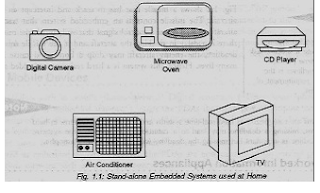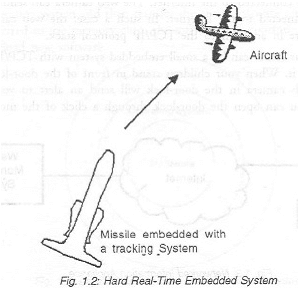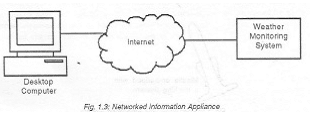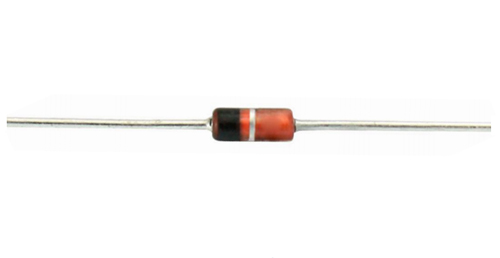What is an Embedded System?
An embedded system can be defined as a computing device that does a specific focused job. Appliances such as the air-conditioner, VCD player, DVD player, printer, fax machine, mobile phone etc. are examples of embedded systems. Each of these appliances will have a processor and special hardware to meet the specific requirement of the application along with the embedded software that is executed by the processor for meeting that specific requirement. The embedded software is also called “firm ware”. The desktop/laptop computer is a general purpose computer. You can use it for a variety of applications such as playing games, word processing, accounting, software development and so on. In contrast, the software in the embedded systems is always fixed.
History:
In the earliest years of computers in the 1940s, computers were sometimes dedicated to a single task, but were too large to be considered "embedded". Over time however, the concept of programmable controllers developed from a mix of computer technology, solid state devices, and traditional electromechanical sequences.
The first recognizably modern embedded system was the Apollo Guidance Computer, developed by Charles Stark Draper at the MIT Instrumentation Laboratory. At the project's inception, the Apollo guidance computer was considered the riskiest item in the Apollo project. The use of the then new monolithic integrated circuits, to reduce the size and weight, increased this risk.
The first mass-produced embedded system was the Autonetics D-17 guidance computer for the Minuteman (missile), released in 1961. It was built from transistorlogic and had a hard disk for main memory. When the Minuteman II went into production in 1966, the D-17 was replaced with a new computer that was the first high-volume use of integrated circuits. This program alone reduced prices on quad nand gate ICs from $1000/each to $3/each, permitting their use in commercial products.
Since these early applications in the 1960s, embedded systems have come down in price. There has also been an enormous rise in processing power and functionality. For example the first microprocessor was the Intel 4004, which found its way into calculators and other small systems, but required external memory and support chips.
In 1978 National Engineering Manufacturers Association released the standard for a programmable microcontroller. The definition was an almost any computer-based controller. They included single board computers, numerical controllers, and sequential controllers in order to perform event-based instructions.
By the mid-1980s, many of the previously external system components had been integrated into the same chip as the processor, resulting in integrated circuits called microcontrollers, and widespread use of embedded systems became feasible.
As the cost of a microcontroller fell below $1, it became feasible to replace expensive knob-based analog components such as potentiometers and variable capacitors with digital electronics controlled by a small microcontroller with up/down buttons or knobs. By the end of the 80s, embedded systems were the norm rather than the exception for almost all electronics devices, a trend which has continued since.
Embedded systems are characterized by some special features listed below:
Ø Embedded systems do a very specific task; they cannot be programmed to do different things. . Embedded systems have very limited resources, particularly the memory. Generally, they do not have secondary storage devices such as the C DROM or the floppy disk. Embedded systems have to work against some deadlines. A specific job has to be completed within a specific time. In some embedded systems, called real-time systems, the deadlines are stringent. Missing a deadline may cause a catastrophe-loss of life or damage to property. Embedded systems are constrained for power. As many embedded systems operate through a battery, the power consumption has to be very low.
Ø Embedded systems need to be highly reliable. Once in a while, pressing ALT-CTRL-OEL is OK on your desktop, but you cannot afford to reset your embedded system.
Ø Some embedded systems have to operate in extreme environmental conditions such as very high temperatures and humidity.
Ø Embedded systems that address the consumer market (for exam-ple, electronic toys) are very cost-sensitive: Even a reduction of $0.1 is lot of cost saving, because thousands or millions systems may be sold.
Ø Unlike desktop computers in which the hardware platform is dominated by Intel and the operating system is dominated by Microsoft, there is a wide variety of processors and operating systems for the embedded systems. So, choosing the right plat-form is the most complex task.
APPLICATION AREAS
Nearly 99 per cent of the processors manufactured end up in embedded systems. The embedded system market is one of the highest growth areas as these systems are used in very market segment- consumer electronics, office automation, industrial automation, biomedical engineering, wireless communication, data communication, telecommunications, transportation, military and so on.
Consumer appliances: At home we use a number of embedded systems which include digital camera, digital diary, DVD player, electronic toys, microwave oven, remote controls for TV and air-conditioner, VCO player, video game consoles, video recorders etc. Today’s high-tech car has about 20 embedded systems for transmission control, engine spark control, air-conditioning, navigation etc. Even wristwatches are now becoming embedded systems. The palmtops are powerful embedded systems using which we can carry out many general-purpose tasks such as playing games and word processing.
Office automation: The office automation products using embedded systems are copying machine, fax machine, key telephone, modem, printer, scanner etc. Industrial automation: Today a lot of industries use embedded systems for process control. These include pharmaceutical, cement, sugar, oil exploration, nuclear energy, electricity generation and transmission. The embedded systems for industrial use are designed to carry out specific tasks such as monitoring the temperature, pressure, humidity, voltage, current etc., and then take appropriate action based on the monitored levels to control other devices or to send information to a centralized monitoring station. In hazardous industrial environment, where human presence has to be avoided, robots are used, which are programmed to do specific jobs. The robots are now becoming very powerful and carry out many interesting and complicated tasks such as hardware assembly.
CATEGORIES OF EMBEDDED SYSTEMS
Based on functionality and performance requirements, embedded systems can be categorized as:
• Stand-alone embedded systems
• Real-time systems
• Networked information appliances
• Mobile devices
Stand alone Embedded Systems:
As the name implies, stand-alone systems work in stand-alone mode. They take inputs, process them and produce the desired output. The input can be electrical signals from transducers or commands from a human being such as the pressing of a button. The output can be electrical signals to drive another system, an LED display or LCD display for displaying of information to the users. Embedded systems used in process co~1’rol, automobiles, consumer electronic items etc. fall into this category. In a process control system, the inputs are from sensors that convert a physical entity such as temperature or pressure into its equivalent electrical signal. These electrical signals are processed by the system and the appropriate electrical signals are produced using which an action is taken such as opening a valve. A few embedded systems used at home are shown in fig
REAL TIME SYSTEMS
Embedded systems in which some specific work has to be done in a specific time period are called real-time systems. For example, consider a system that has to open a valve within 30milliseconds when the humidity crosses a particular threshold. If the valve is not opened within 30 milliseconds, a catastrophe may occur. Such systems with strict deadlines are called hard real-time’ systems. In some embedded systems, deadlines are imposed, but not adhering to them once in a while may not lead to a catastrophe. For example, consider a DVD player. Suppose, you give a command to the DVD player from remote control, and there is a delay of a few milliseconds in executing that command. But, this delay won’t lead to a serious implication. Such systems are called soft real-time systems.
NETWORKED INFORMATION APPLIANCES
Embedded systems that are provided with network interfaces and accessed by networks such as Local Area Network or the Internet are called networked information appliances. Such embedded systems are connected to a network, typically a network running TCP/IP (Transmission Control Protocol! Internet Protocol) protocol suite, such as the Internet or a company’s Intranet. These systems have emerged in recent years These systems run the protocol TCP/IP stack and get connected either through PPP or Ethernet to a network and communicate with other nodes in the network. Here are some examples of such systems:
MOBILE DEVICES
Mobile devices such as mobile phones, Personal Digital Assistants (PDAs), smart phones etc. are a special category of embedded systems. Though the PDAs do many general purpose tasks, they need to be designed just like the ‘conventional’ embedded systems. The limitations of –the mobile devices- memory constraints, small size, lack of good user interfaces such as full-fledged keyboard and display etc.-are same as those found in the embedded systems discussed above. Hence, mobile devices are considered as embedded systems. However, the PDAs are now capable of supporting general-purpose application software such as word processors, games, etc.
User interfaces
Embedded systems range from no user interface at all - dedicated only to one task - to full user interfaces similar to desktop operating systems in devices such as PDAs.
Simple systems
Simple embedded devices use buttons, LEDs, and small character- or digit-only displays, often with a simple menu system.
In more complex systems
A full graphical screen, with touch sensing or screen-edge buttons provides flexibility while minimizing space used: the meaning of the buttons can change with the screen, and selection involves the natural behavior of pointing at what's desired. Handheld systems often have a screen with a "joystick button" for a pointing device. The rise of the World Wide Web has given embedded designers another quite different option: providing a web page interface over a network connection. This avoids the cost of a sophisticated display, yet provides complex input and display capabilities when needed, on another computer. This is successful for remote, permanently installed equipment. In particular, routers take advantage of this ability.
CPU platform
Embedded processors can be broken into two distinct categories: microprocessors (μP) and micro controllers (μC). Micro controllers have built-in peripherals on the chip, reducing size of the system. There are many different CPU architectures used in embedded designs such as ARM, MIPS, Cold fire/68k, PowerPC, x86, PIC, 8051, Atmel AVR, Renesas H8, SH, V850, FR-V, M32R, Z80, Z8, etc. This in contrast to the desktop computer market, which is currently limited to just a few competing architectures. PC/104 and PC/104+ are a typical base for small, low-volume embedded and rugged system design. These often use DOS, Linux, NetBSD, or an embedded real-time operating system such as QNX or VxWorks. A common configuration for very-high-volume embedded systems is the system on a chip (SoC), an application-specific integrated circuit (ASIC), for which the CPU core was purchased and added as part of the chip design. A related scheme is to use a field-programmable gate array (FPGA), and program it with all the logic, including the CPU.
Peripherals
Embedded Systems talk with the outside world via peripherals, such as:
Ø Serial Communication Interfaces (SCI): RS-232, RS-422, RS-485 etc
Ø Synchronous Serial Communication Interface: I2C, JTAG, SPI, SSC and ESSI
Ø Universal Serial Bus (USB)
Ø Networks: Controller Area Network, LonWorks, etc
Ø Timers: PLL(s), Capture/Compare and Time Processing Units
Ø Discrete IO: aka General Purpose Input Output (GPIO)
Tools
As for other software, embedded system designers use compilers, assemblers, and debuggers to develop embedded system software. However, they may also use some more specific tools:
Ø An in-circuit emulator (ICE) is a hardware device that replaces or plugs into the microprocessor, and provides facilities to quickly load and debug experimental code in the system.
Ø Utilities to add a checksum or CRC to a program, so the embedded system can check if the program is valid.
Ø For systems using digital signal processing, developers may use a math workbench such as MathCAD or Mathematic to simulate the mathematics.
Ø Custom compilers and linkers may be used to improve optimization for the particular hardware.
Ø An embedded system may have its own special language or design tool, or add enhancements to an existing language.
Software tools can come from several sources:
Ø Software companies that specialize in the embedded market
Ø Ported from the GNU software development tools
Ø Sometimes, development tools for a personal computer can be used if the embedded processor is a close relative to a common PC processor
Debugging
Embedded Debugging may be performed at different levels, depending on the facilities available, ranging from assembly- or source-level debugging with an in-circuit emulator or in-circuit debugger, to output from serial debug ports or JTAG/Nexus interfaces, to an emulated environment running on a personal computer.As the complexity of embedded systems grows, higher level tools and operating systems are migrating into machinery where it makes sense. For example, cell phones, personal digital assistants and other consumer computers often need significant software that is purchased or provided by a person other than the manufacturer of the electronics. In these systems, an open programming environment such as Linux, NetBSD, OSGi or Embedded Java is required so that the third-party software provider can sell to a large market.
Reliability
Embedded systems often reside in machines that are expected to run continuously for years without errors, and in some cases recover by themselves if an error occurs. Therefore the software is usually developed and tested more carefully than that for personal computers, and unreliable mechanical moving parts such as disk drives, switches or buttons are avoided.Recovery from errors may be achieved with techniques such as a watchdog timer that resets the computer unless the software periodically notifies the watchdog.
Specific reliability issues may include:
Ø The system cannot safely be shut down for repair, or it is too inaccessible to repair. Solutions may involve subsystems with redundant spares that can be switched over to, or software "limp modes" that provide partial function. Examples include space systems, undersea cables, navigational beacons, bore-hole systems, and automobiles.
Ø The system must be kept running for safety reasons. "Limp modes" are less tolerable. Often backups are selected by an operator. Examples include aircraft navigation, reactor control systems, safety-critical chemical factory controls, train signals, engines on single-engine aircraft.
Ø The system will lose large amounts of money when shut down: Telephone switches, factory controls, bridge and elevator controls, funds transfer and market making, automated sales and service.
High vs Low Volume
For high volume systems such as portable music players or mobile phones, minimizing cost is usually the primary design consideration. Engineers typically select hardware that is just “good enough” to implement the necessary functions. For low-volume or prototype embedded systems, general purpose computers may be adapted by limiting the programs or by replacing the operating system with a real-time operating system.
Embedded software architectures
There are several different types of software architecture in common use.
Simple control loop
In this design, the software simply has a loop. The loop calls subroutines, each of which manages a part of the hardware or software.
Interrupt controlled system
Some embedded systems are predominantly interrupt controlled. This means that tasks performed by the system are triggered by different kinds of events. An interrupt could be generated for example by a timer in a predefined frequency, or by a serial port controller receiving a byte. These kinds of systems are used if event handlers need low latency and the event handlers are short and simple. Usually these kinds of systems run a simple task in a main loop also, but this task is not very sensitive to unexpected delays. The tasks performed in the interrupt handlers should be kept short to keep the interrupt latency to a minimum. Some times longer tasks are added to a queue structure in the interrupt handler to be processed in the main loop later. This method brings the system close to a multitasking kernel with discrete processes. Cooperative multitasking
A no preemptive multitasking system is very similar to the simple control loop scheme, except that the loop is hidden in an API. The programmer defines a series of tasks, and each task gets its own environment to "run" in. Then, when a task is idle, it calls an idle routine (usually called "pause", "wait", "yield", etc.). The advantages and disadvantages are very similar to the control loop, except that adding new software is easier, by simply writing a new task, or adding to the queue-interpreter.
Preemptive multitasking
In this type of system, a low-level piece of code switches between tasks based on a timer. This is the level at which the system is generally considered to have an "operating system", and introduces all the complexities of managing multiple tasks running seemingly at the same time. Any piece of task code can damage the data of another task; they must be precisely separated. Access to shared data must be controlled by some synchronization strategy, such as message queues, semaphores or a non-blocking synchronization scheme. Because of these complexities, it is common for organizations to buy a real-time operating system, allowing the application programmers to concentrate on device functionality rather than operating system services.





I have found that this site is very informative, interesting and very well written. keep up the nice high quality writing. Desentupidora em Indaiatuba
ReplyDelete